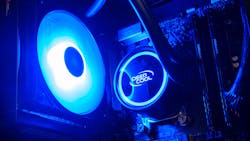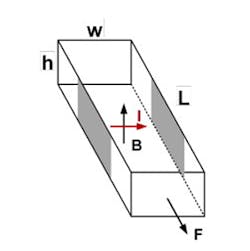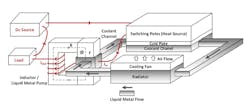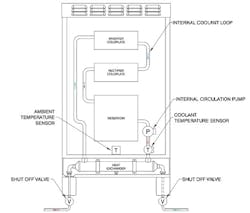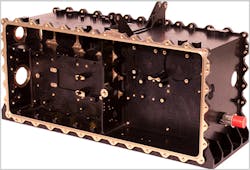Power Density in Liquid-Cooled Power Converters
This article is part of the Power Management Series: Delving Into Power Density.
Members can download this article in PDF format.
What you'll learn:
- Cooling with liquid metal.
- Details about a microchannel cold-plate manifold heatsink cooling system.
- Liquid cooling possibilities for aircraft.
Power-supply electronic designs are constantly striving for miniaturization with optimum power density. And, no doubt, such miniaturization will need more advanced thermal-management solutions. In the past, power-converter architectures have employed forced or natural convection cooling.
One key thermal-management technique for those shrinking power supplies and higher levels of power is liquid cooling, which has the ability of high heat removal.
Designers must carefully approach liquid-cooling solutions, though. They should consider what kind of electrical power topology that will best serve the design, size constraints in the physical environment, component temperature ratings, simplest manufacturing, and repeatability that will lead to optimal system cost and quality control.
Dealing with WBG Power-Device Designs
Savvy designers know that power-management designs using wide-bandgap (WBG) semiconductors greatly improve efficiency and power density. However, employing WBG power devices in power-circuit designs may lead to a drawback, which is a reduced footprint. This can increase heat-flux density that will negatively affect some of the benefits of power density. Enter liquid-cooling systems.
Liquid-Metal-Based Cooling
Various methods are used in liquid-cooling systems. One uses a non-toxic gallium alloy-based coolant that’s in a liquid state at room temperature. This liquid metal coolant is superior to a water coolant in that it will significantly reduce the cold plate thermal resistance.1
Plus, the liquid metal has the property of electrical conductivity that enables it to move the fluid through an electromagnetic pump, which doesn’t use rotating drives. A Lorentz force (F) is created when a current (I) is applied across the channel (Fig. 1). The channel is filled with conductive liquid metal while in the presence of a magnetic field (B) perpendicular to that current.
A novel architecture, similar to a DC MHD pump, is composed of a liquid-metal-based cooling system built around an inductor-integrated liquid-metal magnetohydrodynamic (i2MHD) pump. This method eliminates the need for an auxiliary power supply and permanent magnets, improves cooling capability and power density, and consumes much less power.
A Proposed i2MHD Pump
The operation principles of a conventional inductor-integrated pump are quite similar to a basic DC MHD pump. A constant magnetic field is applied to the pump channel via a pair of permanent magnets. The pumping current is injected through copper electrodes by means of an external auxiliary power supply.
Instead of using permanent magnets to provide the magnetic field, the i2MHD pump (Fig. 2) utilizes the magnetic field produced by the integrated inductor, which is operated in a buck power converter.2 Also, instead of using an external auxiliary power source to inject current into the channel, the inductor current will be utilized as the current that flows through the liquid metal coolant channel.
The i2MHD pump enables higher heat dissipation, improved reliability, and less power consumption. This design will, in turn, lead to an excellent cooling system for high-power-density, electronic power-supply designs.
An Efficient and High-Power-Density, Microchannel Cooling Technique for Multiple Power Electronic Devices
Seemingly every decade, the power density of power electronic devices has roughly doubled. To combat the ensuing heat, a technique was developed to enable energy-efficient, compact cooling of power electronic devices (PEDs). The technique employs many miniaturized, microfluidic cold plates that are attached to transistors to allow for the local heat removal.
An integrated, microchannel, cold-plate manifold heatsink cooling system is proposed to cool down 20 gallium-nitride (GaN) transistors in a 2.5-kW switched-capacitor dc-dc converter.3 During operation of the converter, the liquid-cooled flow rate was fixed at 1 ml/s.
This cooling system design is made up of silicon cold plates containing channels of micrometer-sized fluid coolant channels, along with a manifold that’s able to distribute coolants to hotspots on a printed circuit board (PCB). The total mass of the cold plates is quite low, and the overall system has a small thermal inertia, leading to a steady state being obtained within only a few minutes.
Custom Marine Liquid-Cooled Power
A different design route involves the liquid-cooled series of shore power converters, which range in power from 15 to 165 kVA and are internally oil-cooled (this is perfect in a warm environment).4 A water-cooling loop, managed by the user, will carry away heat energy from a cooling oil by means of a base-mounted heat exchanger (Fig. 3). The primary oil reservoir is sealed and splash-proof.
These liquid-cooled power converters are designed in a high-power-density architecture. They employ a dual-conversion technology whereby the shore power service is isolated via a transformer and is further converted to dc power by means of a dc power-supply module.
Challenges and Solutions for Liquid Cooling in Aircraft
More electric aircraft (MEA) designers have a monumental task to create improved processing without burdening the aircraft with higher power consumption and weight.5
Some ways to attack this challenging problem include replacing pneumatic and hydraulic systems with a state-of-the-art electrical system. However, liquid cooling looks like a welcome power-management technology that may help solve these issues.
Designers can now switch from air-cooling to liquid-cooling techniques, which will mitigate thermal restrictions so that system performance and reliability will not be compromised. Reducing operating temperatures will enable lowering power consumption and weight that, in turn, will increase meantime between failures of aircraft equipment.
High-power modules and high-power-density components can be effectively cooled via a liquid-cooled chassis (liquid flow-through, or LFT, electronics chassis) and cold plates (Fig. 4). Heat exchangers will provide cooling of engine or hydraulic fluids and be able to dispose of the heat that gets absorbed by the chassis or cold plates.
The LFT chassis is a board-level heat-absorbing technology consisting of corrugated aluminum fins that are vacuum brazed into the chassis sidewalls. The system heat moves from the PCB conduction to the chassis sidewalls and on to the cooling fluid. An internal fin serves to create an additional surface area to expedite heat transfer and will generate turbulence in the fluid that will lead to optimum cooling performance.
This kind of thermal-cooling design uses aluminum instead of copper, even though copper has a superior thermal conductivity. The reason for using aluminum is its lighter weight (aluminum has close to 50% of the thermal conductivity of copper, with just 30% of the density). It offers the optimum performance-to-weight ratio.
The chassis liquid coolants mostly used are oil, ethylene glycol and water solution (EGW), polyalphaolefin (PAO), or other dielectric fluids like Fluorinert.
Cold Plates
Liquid cold plates are especially key in a liquid-cooled chassis. Technologies used for cold plates include tubed, flat tubed, and performance-fin. The most common vacuum-brazed performance-fin technology is typically used on aircraft. Performance-fin technologies comprise two plates that are metallurgically bonded together with an internal fin. The cold-plate fluid is usually cooled via a heat exchanger.
Heat Exchangers
Two types of heat exchangers are commonly found on aircraft: plate-fin and flat-tube. An aircraft heat exchanger is typically used to cool auxiliary power units, hydraulics, gearboxes, and more.
The heat exchanger is usually designed for high performance when poor heat-transfer fluids like ethylene glycol and oil solutions are used. Heat exchangers in aircraft are frequently employed for the cooling of engine oil, hydraulic oil, and EGW with ram air by means of a ram-air intake system or utilizing a fan.
Summary
Using liquid cooling will enable far better performance than simply using air cooling. Liquid cooling is typically quieter than air cooling and may prove insensitive to altitude. The technology also can reduce weight and power consumption by doing away with the need for large fans or the method of widely spaced components. Liquid-cooled chassis, cold plates, and heat exchangers will adequately provide complete thermal solutions for aircraft fluid cooling as well as all associated electronics.
Read more articles in the Power Management Series: Delving Into Power Density.
References
1. Liquid Metal based Cooling for Power Electronics Systems with Inductor Integrated Magnetohydrodynamic Pump (MHD Pump), IEEE 2021.
2. Optimized Liquid-Cooled Power Converters, Astrodyne TDI, 2020.
3. Efficient Microchannel Cooling of Multiple Power Devices With Compact Flow Distribution for High Power-Density Converters, IEEE Transactions on Power Electronics, Vol. 35, No. 7, July 2020.
4. A SEA Power Systems, Custom marine power solutions, A Mission Critical Electronics Brand.
5. Aircraft Liquid Cooling, Boyd 2022.
